David Payne (1843-1894) was a British landscape artist whose work captured the serene beauty and idyllic charm of the English countryside during the latter half of the 19th century. Working in a period of significant artistic change and diversification, Payne developed a distinctive style characterized by its gentle realism, atmospheric qualities, and an idealized vision of rural life. Though perhaps not as widely known today as some of his bombastic contemporaries, his contributions to Victorian landscape painting offer a valuable window into the artistic sensibilities and pastoral affections of his era.
Early Life and Artistic Awakenings
David Payne was born in 1843 in Annan, a town in Dumfries and Galloway, Scotland. He was the son of William Payne and Margaret Rodgson. From an early age, Payne exhibited a natural aptitude for drawing and painting, a talent that was nurtured during his education at Annan Academy. Like many aspiring artists of modest backgrounds in the 19th century, Payne did not immediately embark on a full-time artistic career. His initial profession was that of a house painter, a trade that, while practical, would have provided him with a foundational understanding of pigments, application techniques, and perhaps an appreciation for surface and finish.
Despite the demands of his trade, Payne continued to pursue his passion for art in his leisure time. His dedication to his craft was unwavering. A significant personal milestone occurred in 1867 when he married Averida Kitchen Adina. The couple's life took a new turn in 1871 when they relocated to Derby, a town in the East Midlands of England. This move would prove pivotal for Payne's artistic development, placing him in an environment conducive to his burgeoning ambitions as a painter.
The Influence of George Turner and Professional Ascent
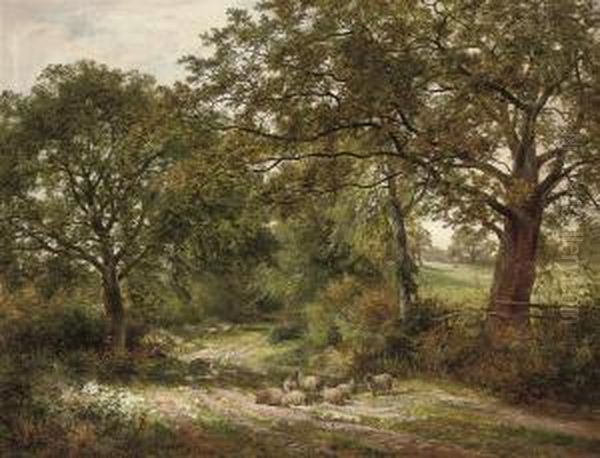
After settling in Derby, David Payne eventually made his home in Barrow upon Trent, a village nearby. It was here, or in the surrounding Derbyshire area, that he came under the tutelage of George Turner (1841-1910). Turner, often referred to as "Derbyshire's John Constable," was a largely self-taught but highly successful landscape artist known for his detailed and affectionate portrayals of the Midlands scenery, particularly the Trent Valley. Turner's influence on Payne would have been significant, likely reinforcing Payne's inclination towards realistic depiction, careful observation of nature, and an appreciation for the local landscape.
Under Turner's guidance, or at least inspired by his example and the artistic community in Derbyshire, Payne honed his skills. By 1881, he felt confident enough to transition from a part-time painter to a professional artist, dedicating himself fully to his creative pursuits. This was a bold step, indicative of both his passion and a growing recognition of his talents. His work soon began to appear in significant exhibitions, a crucial step for any professional artist seeking patronage and critical acclaim. Payne exhibited at the Royal Birmingham Society of Artists, the Nottingham Museum and Art Gallery, and, notably, the prestigious Royal Academy in London. Inclusion in the Royal Academy exhibitions was a mark of considerable achievement and would have brought his work to a national audience.
Artistic Style, Themes, and Techniques
David Payne is primarily celebrated for his landscape paintings, which predominantly depict the tranquil and often bucolic scenery of the English countryside. His artistic style can be described as an idealized realism, characteristic of much late 19th-century landscape painting that sought to present nature in a harmonious and aesthetically pleasing light, often evoking a sense of nostalgia or peaceful retreat from the increasing industrialization of Britain.
Payne's canvases often convey a gentle, subdued beauty. He was adept at capturing the specific moods and atmospheres of the English landscape, paying close attention to the effects of light and weather. His palette, while capable of richness, often favored softer, more muted tones that enhanced the tranquility of his scenes. There is a pervasive sense of calm in his work, a quiet appreciation for the enduring charm of rural England. He was known to work en plein air (outdoors), a practice popularized by the Barbizon School painters in France like Jean-Baptiste-Camille Corot and Charles-François Daubigny, and later central to Impressionism. This direct engagement with nature allowed Payne to capture the fleeting effects of light and atmosphere with greater immediacy and accuracy.
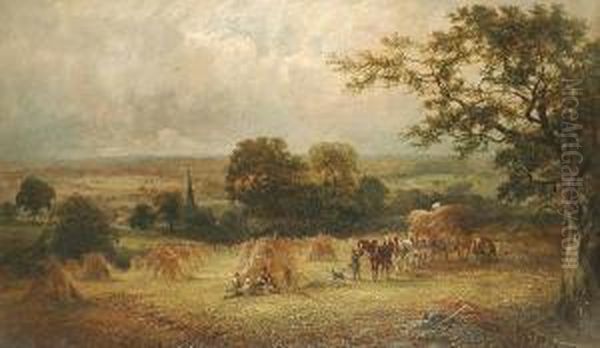
Interestingly, Payne also explored the technique of trompe l'oeil, which translates from French as "deceive the eye." This technique involves creating an optical illusion that makes a two-dimensional painting appear as a three-dimensional object or scene. While landscape was his primary focus, his engagement with trompe l'oeil suggests a versatile artist interested in different modes of representation and illusionistic effects. This was a skill also seen in still life painters of earlier centuries, like the Dutch masters Willem Claesz Heda or Pieter Claesz, and in some 19th-century American painters like William Michael Harnett.
Notable Works and Their Characteristics
Several works by David Payne are noted for exemplifying his style and thematic concerns. Among these, "Sweet Summer," exhibited in 1876, likely encapsulated his idealized vision of the English countryside during its most bountiful season. Such a title evokes images of lush greenery, warm sunlight, and peaceful rural activity, themes that resonated deeply with Victorian audiences.
Another significant piece is "Rural Autumn Harvest Scene." This painting depicts a heartwarming tableau of farm workers resting after their labors in the field, with harvested crops around them. It’s a charming and atmospheric work, imbued with a sense of rustic contentment and the golden light of autumn. Such harvest scenes were popular in Victorian art, celebrating agricultural life and the bounty of the land, a tradition carried on by artists like Myles Birket Foster, known for his highly detailed and often sentimental depictions of rural England.
Payne also worked in watercolour, as evidenced by his "Brent Bridge." This small, vibrantly coloured watercolour, created in Devon, showcases his confidence in this medium and his ability to capture the essence of a scene with freshness and immediacy. Watercolour was a highly respected medium in Britain, with masters like J.M.W. Turner (no direct relation to George Turner) and John Sell Cotman elevating its status.
His versatility extended beyond painting. "The Angler," a carving, won him an award at the Derby Art and Industrial Exhibition in 1862. This early success in a different medium highlights his broader artistic talents and his ability to work in three dimensions, a skill that might have informed his understanding of form in his paintings, including his trompe l'oeil works. The "Landscape with Trompe l'oeil Pigeon" further underscores his interest in this illusionistic technique, blending his primary subject of landscape with the playful deception of trompe l'oeil.
Payne in the Context of the Victorian Art World
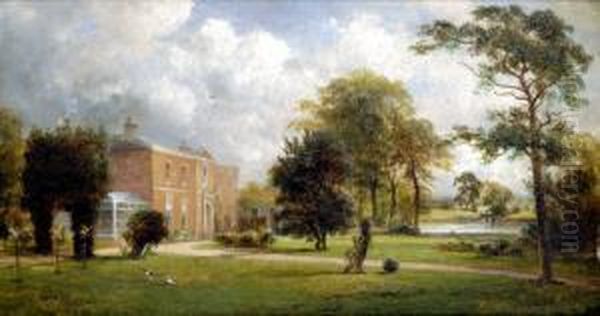
David Payne worked during a vibrant and complex period in British art. The Victorian era saw a flourishing of diverse artistic movements and styles. The Pre-Raphaelite Brotherhood, with artists like Dante Gabriel Rossetti, John Everett Millais, and William Holman Hunt, had earlier challenged Academic conventions with their emphasis on detail, symbolism, and literary themes. Academic art, championed by figures like Lord Frederic Leighton and Sir Lawrence Alma-Tadema, continued to produce grand historical and classical scenes.
Landscape painting itself had a rich tradition in Britain, with the towering figures of John Constable and J.M.W. Turner having revolutionized the genre in the earlier part of the century. By Payne's time, landscape painting encompassed a wide spectrum of approaches. Artists like Benjamin Williams Leader achieved immense popularity with their expansive and meticulously detailed views of the British countryside, often tinged with a romantic sentimentality. Others, such as Alfred de Bréanski Sr. and Sidney Richard Percy of the Williams family of painters, specialized in dramatic Highland scenes or tranquil river views, respectively.
Atkinson Grimshaw was creating his distinctive nocturnal scenes of moonlit cityscapes and docks, offering a more melancholic and atmospheric vision. Meanwhile, the influence of French Impressionism, with its emphasis on capturing fleeting moments and the subjective experience of light and color, was beginning to be felt in Britain through artists like James McNeill Whistler (though American, he was a major figure in London) and later, British artists like Philip Wilson Steer and Walter Sickert.
David Payne's work fits comfortably within the more traditional, yet highly popular, vein of Victorian landscape painting that emphasized recognizable scenery, skilled craftsmanship, and an accessible, often idealized, depiction of nature. His style, while not radically innovative in the manner of the Impressionists, appealed to a public that appreciated the familiar beauty of the English countryside rendered with sensitivity and skill. His connection to George Turner places him within a strong regional school of landscape painting in Derbyshire, an area rich in picturesque scenery that inspired many artists.
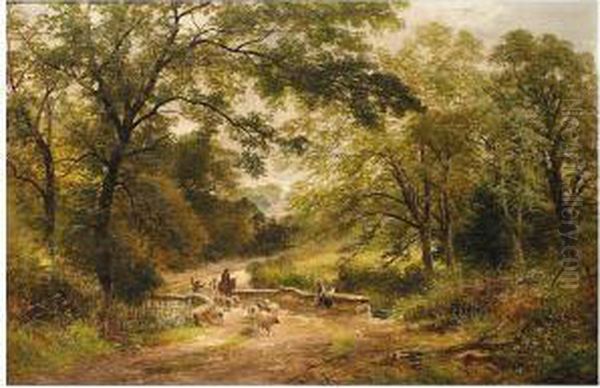
His participation in exhibitions at the Royal Academy and other institutions indicates that his work was well-received within the established art world of his time. These venues were crucial for artists to gain visibility, sell their work, and build their reputations. Payne's success in these arenas suggests that his particular vision of the English landscape resonated with the tastes and values of his contemporaries. He was part of a broad movement of artists who, while perhaps not always at the avant-garde, collectively shaped the visual culture of the Victorian era, providing images of beauty and tranquility that offered a counterpoint to the rapid industrial and social changes of the time.
Later Years and Legacy
David Payne continued to paint and exhibit throughout his career, contributing to the rich tapestry of British landscape art in the late 19th century. His dedication to capturing the serene and gentle aspects of the English countryside provided a consistent and comforting vision for his audience. His works are characterized by their sincerity and a genuine affection for the landscapes he depicted.
Evidence indicates that David Payne passed away in 1894, at the relatively young age of 50 or 51. His death would have cut short a career that was well-established and respected. While he may not have achieved the posthumous fame of some of his more revolutionary contemporaries, his paintings remain as testaments to his skill and his particular artistic vision.
Today, David Payne's works are held in various public and private collections. They are appreciated for their technical competence, their atmospheric charm, and as historical documents that reflect Victorian tastes and the enduring appeal of the English landscape. He represents a significant group of Victorian artists who, while perhaps operating outside the main currents of avant-garde innovation, produced work of high quality that was deeply valued in its time and continues to offer pleasure and insight to viewers today. His connection to a specific region, Derbyshire, through his association with George Turner, also makes him an important figure in the study of regional British art.
His exploration of trompe l'oeil, though perhaps a smaller part of his oeuvre, adds an interesting dimension to his artistic profile, suggesting an intellectual curiosity about the nature of perception and representation that went beyond straightforward landscape depiction. This, combined with his early award for carving, paints a picture of a versatile and skilled craftsman.
Conclusion
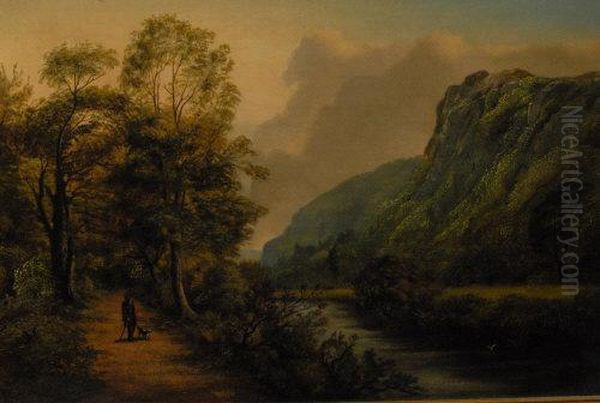
David Payne was a talented and dedicated Victorian artist whose life and work were devoted to capturing the beauty of the English landscape. From his early beginnings in Annan and his trade as a house painter, he rose to become a professional artist, exhibiting at prestigious institutions and gaining recognition for his serene and idealized portrayals of rural England. Influenced by artists like George Turner, he developed a style that, while rooted in the traditions of British landscape painting, possessed its own gentle charm and atmospheric sensitivity.
His paintings, such as "Sweet Summer" and "Rural Autumn Harvest Scene," along with his watercolours and even his forays into trompe l'oeil and sculpture, reveal an artist of considerable skill and quiet passion. In the broader context of Victorian art, Payne's work provided a comforting and aesthetically pleasing vision of nature, a vision that resonated with his contemporaries and continues to be appreciated for its tranquil beauty and historical significance. He remains a noteworthy figure among the many artists who chronicled the diverse facets of 19th-century Britain, leaving behind a legacy of peaceful landscapes that invite contemplation and appreciation for a bygone era.